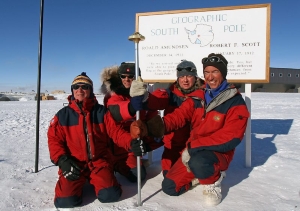Did you know that Amundsen had the date wrong when he reached the South Pole?
The centennial celebrations of the first human visit to our planet’s southern extreme are taking place on December 14 this year. However, Amundsen himself believed the date to be December 15 when he arrived at the South Pole in 1911.
 Four polar explorers with a grip around the clock! Photo: Norwegian Polar Institute
Four polar explorers with a grip around the clock! Photo: Norwegian Polar Institute
Amundsen and his crew left Norway for Antarctica in August 1910, sailing the “Fram” down the Atlantic Ocean, across the Indian Ocean and into the Pacific and Southern Oceans towards Hvalbukta, the Bay of Whales. What they did not consider, were the implications of crossing the 180 degree meridian on their way into the Ross Sea.
This is where east meets west, exactly opposite to the Greenwich meridian (0°), which is the Prime Meridian of the global system of time zones. If travelling east from Greenwich, we have to add one hour to the clock for every 15 degrees of longitude, i.e. every time zone. Over a full circle around the globe this adds up to 24 hours, and thus the traveller would lose a day just like Phileas Fogg in Jules Verne’s novel “Around the World in Eighty Days”.
To avoid this, the 180 degree meridian (with some adjustments) has been designated as the international date line. Going eastwards across this line we must not only adjust the clock, but also go back a day on the calendar. This is why you can fly from New Zealand on a Friday evening and arrive in Hawaii on Friday morning.
For the crew on Fram it meant that they arrived in the Bay of Whales on January 13, 1911, not on the 14th as Amundsen noted in his diary. The error was not corrected until the journey’s end.
On the South Pole the situation becomes even more interesting. The pole is where all longitudes, and hence all time zones meet. If you like, you can clasp your hand around the pole marking the Pole and claim to be spanning 24 hours with your own body – by literally being at all longitudes at the same time!
The real life consequence is that the sun circles the horizon at the exact same elevation throughout the day when it is summer. There is no morning and no evening, just continuous, unchanging daylight around the clock. What time of the day it is, is simply a matter of choice, as the sun is always to the north.
The Amundsen-Scott South Pole Station operates on New Zealand time for practical reasons, but might just as well have chosen Norwegian time, or any other time zone. It makes no difference. Indeed there are people there working at all hours, and to anyone coming off a shift one could always say "dinner time - coming soon to a time zone near you!".